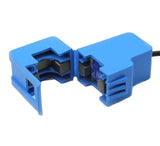CT Electric Sensor
- Core Material Ferrite
- External Material Plastic
- Opening Size: 13 x 13mm/ 0.5 x 0.5"
- Output Plug: 3.5mm
- Dielectric Strength: 6000V AC/1min
- Working Temperature: -25-70°C
- Cable Length: 42"

If an unburdened CT (i.e. one without a burden resistor) is attached to a current-carrying conductor, the CT will generate an unsafe voltage at its leads which could break down the insulation and destroy the C.T.
Our CTs have internal Zener diodes to limit the maximum unburdened voltage output to a safe level. CTs with internal burden resistors (‘the voltage output’ type) are also protected against developing dangerous voltages.
Always connect the C.T. leads before clipping it round a current-carrying conductor, and always un-clip the C.T. from the current-carrying conductor before disconnecting its leads.
Never open-circuit a C.T. whilst it is on a current-carrying conductor. It is always safe to short-circuit a C.T.
Never attempt to fit a C.T. to a bare conductor unless you are absolutely certain it is designed for that. Apart from the obvious danger of electric shock, there are two factors to be considered: the strength of the C.T.'s insulation, and its ability to withstand the higher temperatures at which bare conductors normally operate.
Our split-core CT should never be "clamped" to the cable using any sort of packing material, because the brittle nature of the ferrite core means that it might easily be broken, thus destroying the CT. You should only clamp the CT to the cable or busbar if the housing is specifically designed to do so. Similarly, a ring-core CT should never be forced onto a cable that is too large to pass freely through the center.




